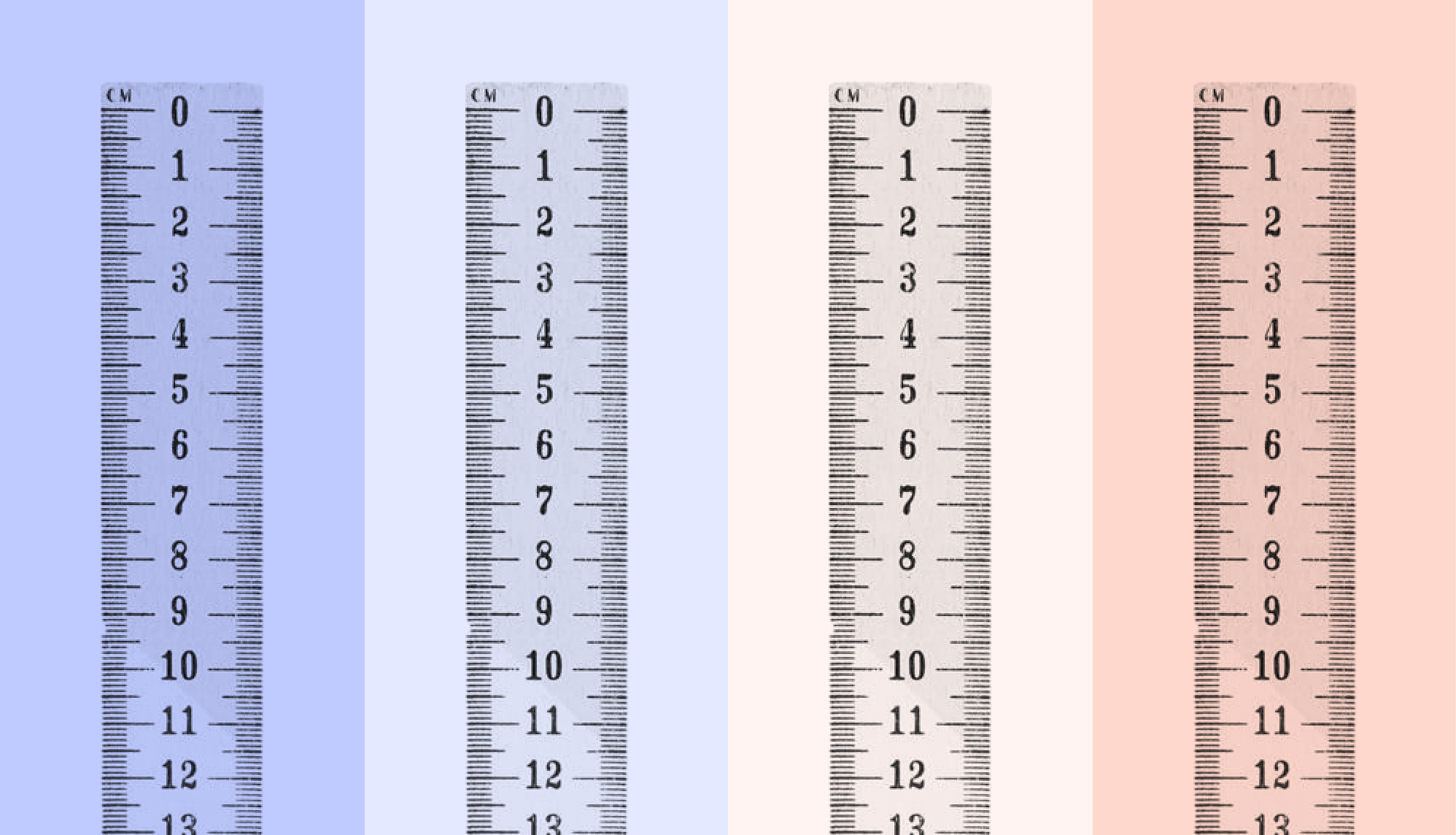Words at work
– 8 min read
What is an adverb? Examples and usage
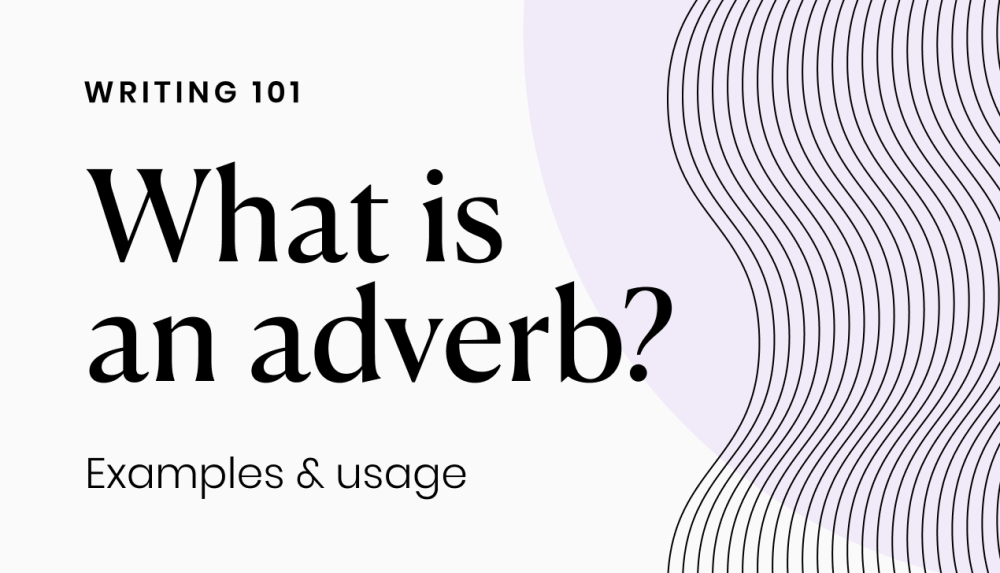
If we were to create a personality profile for adverbs, it’d look something like this:
Name: Adverb
Job: Modifier
Origin: Late Middle English
Criminal record: Unclear
Intrigued about the criminal record? It’s a tad shady since you must avoid adverbs in your writing if they’re not needed. At the same time, they work in the modifying business – explaining time, place, manner, and more. So they’ve some grave responsibility on their shoulders too.
But, to understand all this and more, you’ll need to start with studying adverbs from scratch. So, without further ado, let’s do that. In this post, you’ll learn what is an adverb, their types, examples and you’ll get a list of adverbs too.
Ready? Let’s set sail:
Adverb definition and examples
By way of a formal adverb definition: adverbs are words or phrases that modify or change a verb, adjective, or adverb. Their job as a part of speech is to express time, frequency, manner, degree, level of certainty, and more.
In doing so, adverbs answer common questions such as how, when, where, in what way, and to what extent?
Common adverb examples are:
• Gently
• Timely
• Terribly
• Originally
• Beautifully
• Generously
Note that each of these adverbs end with ‘ly,’ which makes it a prominent suffix to identify adverbs. The keyword here, however, is most adverbs. Meaning: not all adverbs end with ‘ly.’ For example, never, least, and fast are three words that show no sign of the suffix.
That said, adverbs aren’t always individual words. Sometimes, they can be a group of words.
Here are examples of adverbs as phrases:
• As long as
• Until then
• Throughout the party
Oh and before we hop on to a new section, let’s also tell you: in English language, adverbs come from Latin adverbium.
When broken down, adverb literally comes from:
‘ad’ meaning expressing addition and ‘verbum’ meaning word or verb.
In retrospect, adverbs are indeed responsible for doing the additional work of modifying verbs and other words. It’s for this reason that it’s safe to call an adverb a modifying adverb.
That said, there can be multiple adverbs in a sentence. Here’s an example:

In this instance, ‘extremely’ modifies ‘difficult,’ an adjective. Moreover, ‘pretty’ describes the adverb ‘well.’
With the basic adverb definition and examples out of the way, we’ve covered the fundamentals of adverbs in English. There’s only one thing that needs explaining now: adverbs as phrases.
Adverbial phrases and adverbial clauses
In the definition, we noted, adverbs are words and phrases. When a group of words take on an adverb’s job, their designation also changes from adverbs to adverbial phrases.
Example of adverbial phrase:

If you say, Hannah’s migraine left her sitting silently, you’re using an adverb. With the two words involved in the example above, you can tell an adverbial phrase is at work.
Like an adverb, adverbial phrases work to express how, when, in what manner, and to what degree something happens.
So if an adverbial phrase is a group of words, what’s an adverbial clause?
An adverbial clause is one that contains a subject and verb. Like adverbial phrases, these are groups of words delivering the same adverbial function. Unlike an adverbial phrase though, an adverbial clause contains a subject and verb.
Example of adverbial clause:
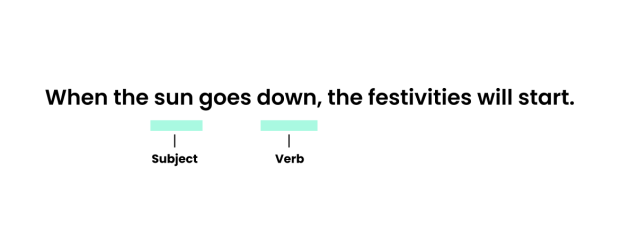
Quick tip: Adverbial clauses are adjuncts or dependent clauses. This means that they can’t stand on their own as a meaningful sentence.
Altogether, here’s an examples-based comparative chart:
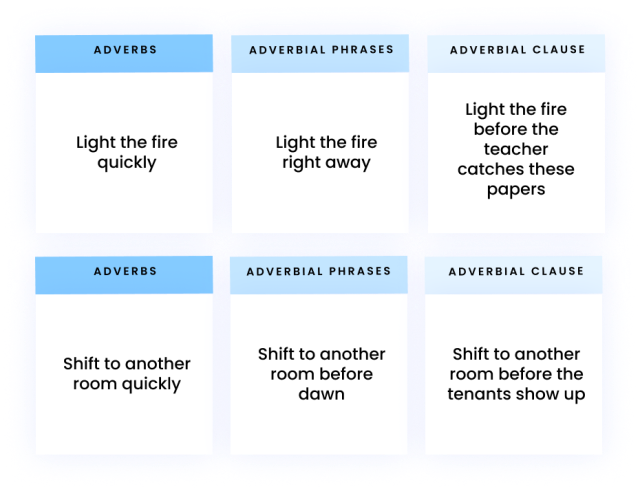
Types of adverbs
There are five types of adverbs. These are:
1. Adverbs of time and frequency
2. Adverbs of manner
3. Adverbs of degree
4. Adverbs of place and direction
5. Conjunctive adverbs
Adverbs of time and frequency explain when and for how long.
Example:
The kids will stay over at Alex’s home.
Note: When an adverbial phrase is used to denote time, it turns the phrase into a prepositional phrase. Why? Because such an adverbial phrase relies on a preposition (part of speech expressing position – example: on, in, by, after, under).
Next up, adverbs of manner indicate how.
Example:
She gently stroked her hair.
The third type, adverbs of degree suggest the extent of something.
Example:
He completely forgot to pick his kid from the school.
What’s more, adverbs of place and direction specify the location, answering where.
Example:
By the time I reached her, it was a little late.
Lastly, conjunctive adverbs are connectors or linking adverbs. They help bridge transition between thoughts and ideas. Conjunctive adverbs show relationships too.
Example:
Despite the heavy rain last night, the sky has cleared.
List of common adverbs
As promised, here’s a handy list of adverbs. We’ve divided it by the types of adverb so you can pull out one from any category you need it for.
Adverbs of time
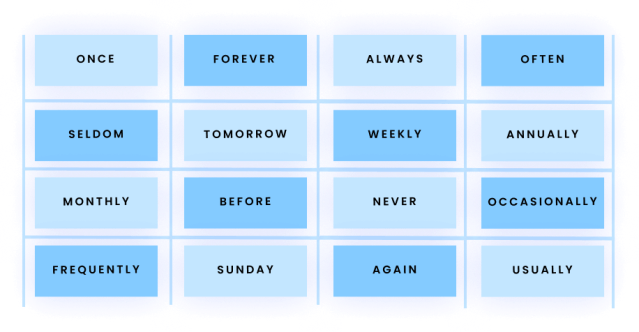
Adverbs of manner

Adverbs of degree

Adverbs of location

Conjunctive adverbs

How to use adverbs
In English grammar, the use of adverbs takes some work. To help you start, I’ve divided the use of adverbs with other parts of speech. Read on.
Adverb + verb
To refresh, verbs are action words. When adverbs modify them, they explain how an action is performed.
Example:
Sabrina gently tugged her doll in the bed.
Here, ‘gently’ tells how Sabrina ‘tugged’ (a verb) her doll.
Adverb + adjective
Adjectives are also modifiers, but they describe nouns.
Example:
Caleb served freshly baked bread.
‘Freshly’ is the adverb here that describes ‘bread,’ a noun. And ‘baked’ describes the noun.
Adverb + adverb
A modifying word describing another modifying makes this combination.
Example:
She finished the bottle of soda remarkably quickly.
Here ‘remarkably’ and ‘quickly’ are both adverbs with one modifying another.
Bonus: adverb modifying entire sentences
In certain instances, adverbs can change entire sentences, which gives them their name, sentence adverbs. Their role? They describe the whole sentence – changing it fully – instead of describing anything particular as common adverbs do.
Examples of sentence adverbs include:
fortunately, apparently, accordingly, generally, interestingly.
Let’s look at this in a sentence:
Fortunately, she survived the surgery.
See that in this sentence, fortunately, sets the tone, therefore, impacting the entire sentence – not just one thing in it.
Tips for using adverbs like the pros
Keep these four tips front and center of your mind as you use adverbs:
Don’t use adverbs as dangling modifiers
When adverbs dangle, they’re typically at the end of the sentence. Their position doesn’t make sense, which is why they’re referred to as dangling modifiers.
Example:

‘With chocolate’ is a dangling modifier here. The correct version is:

Still getting your paper back with red marks around dangling modifiers? That’s okay. It takes time and practice to polish the use of adverbs. And, here’s a shortcut: start a free Writer trial to identify dangling modifiers so you can change them.
Use commas with adverbial phrases thoughtfully
When you write an adverbial phrase at the beginning of a sentence, you need a comma. In this case, the adverb is called a fronted adverbial. Literally, because it’s at the front of the sentence.
Here’s how.
With comma: At 8 pm, dinner is served.
Without comma: Dinner is served at 8 pm.
Get rid of intensifiers
Intensifiers strengthen an expression or stress on something. As is clear from their name, these are adverbs and adverbial phrases that ‘intensify.’
Common intensifiers are: extremely, completely, totally, utterly, absolutely, really, highly. Even ‘very’ works in the same double S (strengthening and stressing) department.
At times, however, intensifiers are useless. So you need to remove them. But, wait, what would do the double S job then? A strong word. The following example will clear this:
Intensifier: Her son was very angry.
Strong word: Her son was livid.
See how livid and very angry make a difference in the writing. Even though they don’t have different meanings, their description styles are different.
Quick reminder: Good writing is strong writing where each word is carefully selected. By removing intensifiers, you’re working to this end. The result? Clear, crisp, and impactful writing.
Ditch comparative and superlative forms of adverbs for stronger ones
Lastly, use stronger adverbs (or, even, verbs and adjectives) instead of comparative and superlative adverbs. This is true for flat adverbs (aka bare adverbs) that have the same form as their corresponding adjective. For example: drive slow.
When to avoid adverbs
We’ve pretty much answered that above when we talked about intensifiers. The American author, Stephen King, was probably thinking of intensifiers when he said,
“The road to hell is paved with adverbs.”
Here’s a useless-adverbs-eradicating action plan:
• Read through your writing and underline all adverbs you’ve used.
• Revisit each adverb and ask yourself: is it necessary? Can my sentence do without it?
• Be extra cautious of intensifiers such as ‘very + adverb.” Replace these with strong words.






